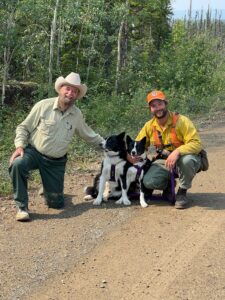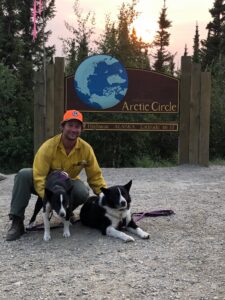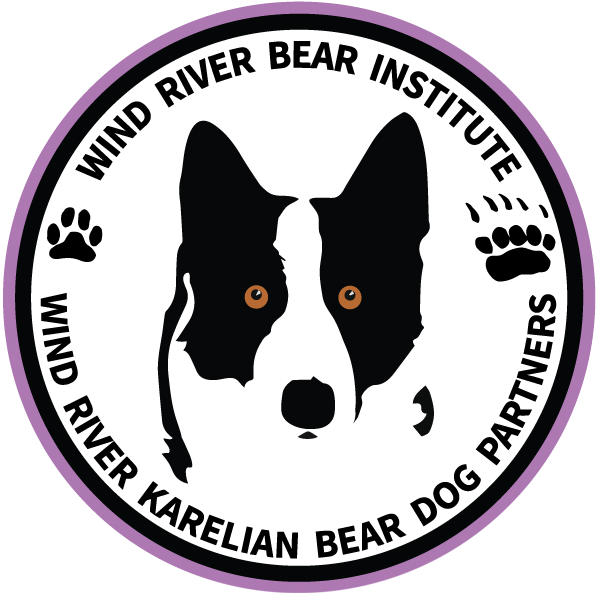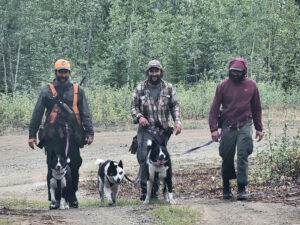 Protection. Insurance. Morale boosters. This is how firefighters on the Dalton Highway Complex describe Mardy and Rio, the two Karelian bear dogs who help to keep them safe from bears, moose, and other large animals. Currently, firefighters on the northern end of the complex are camping at the Artic Circle Campground. These dogs and their handler are a necessary part of keeping firefighters on the complex safe. It isn’t only about keeping the firefighters safe though, it is about education and keeping wildlife safe from encounters with humans.
Protection. Insurance. Morale boosters. This is how firefighters on the Dalton Highway Complex describe Mardy and Rio, the two Karelian bear dogs who help to keep them safe from bears, moose, and other large animals. Currently, firefighters on the northern end of the complex are camping at the Artic Circle Campground. These dogs and their handler are a necessary part of keeping firefighters on the complex safe. It isn’t only about keeping the firefighters safe though, it is about education and keeping wildlife safe from encounters with humans.
The dogs and their handler, Nils Pedersen, are a Wildlife K-9 team from Wind River Bear Institute. Wind River is a non-government organization that develops, teaches, and encourages successful non-lethal deterrence methods to prevent harmful encounters with wildlife. Wind River was founded 27 years ago by Carrie Hunt, the wildlife biologist and researcher who developed the widely used capsaisin bear spray formula.
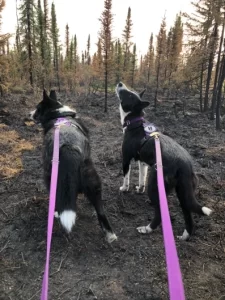 Karelian bear dogs originated in eastern Finland, where they were traditionally used to locate and then hold game in place for hunters by barking. Characteristically quick, agile, and eager hunters, these intelligent dogs are also independent, brave, trustworthy, and protective. They are also not aggressive toward humans.
Karelian bear dogs originated in eastern Finland, where they were traditionally used to locate and then hold game in place for hunters by barking. Characteristically quick, agile, and eager hunters, these intelligent dogs are also independent, brave, trustworthy, and protective. They are also not aggressive toward humans.
Part of the team’s job as human-bear conflict specialists is to patrol the fire camp several times a day to detect any bears, or other large wildlife, in the area. But their most important job is to prevent wildlife encounters in the first place by minimizing “rewards,” such as easy access to food. The team has also installed passive deterrents in the form of electric fences around attractive substances.
“A little bit of prevention is worth a large amount of response” to bear encounters, Nils said.
Nils starts by teaching firefighters about how to avoid attracting bears to camp. He checks the proposed campsite with them, making sure it’s not already frequented by bears or a travel corridor. Once a suitable campsite is found, a single, centralized location is designated for storing all attractants, like human foods and chainsaw bar oil. An electrified bear fence is then constructed around the storage area. The electrified bear fence consists of a solar battery (0.2 to 1.0 joules), a roll of heavy wire around 1/8-inch thick, four to eight posts pounded into the ground plus a few more for bracing, and flagging.
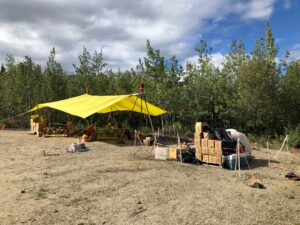 Keeping a clean camp is a must. In the Arctic Circle campground, special bear-proof trash containers have been installed. The pit toilets are constructed with cinder blocks and steel doors, and are maintained to minimize odors. The crews are told not to bring any attractants into their tents, including toothpaste. Bears have a sense of smell that is seven times as strong as a dog’s, so the crews have to do everything possible to minimize the odors they produce and wear. Nils suggests using lockable coolers such as a Coho cooler for cold storage if a tundra cooler isn’t being used. All attractants need to be kept within the electric fence compound.
Keeping a clean camp is a must. In the Arctic Circle campground, special bear-proof trash containers have been installed. The pit toilets are constructed with cinder blocks and steel doors, and are maintained to minimize odors. The crews are told not to bring any attractants into their tents, including toothpaste. Bears have a sense of smell that is seven times as strong as a dog’s, so the crews have to do everything possible to minimize the odors they produce and wear. Nils suggests using lockable coolers such as a Coho cooler for cold storage if a tundra cooler isn’t being used. All attractants need to be kept within the electric fence compound.
Nils also instructs the crews on bear awareness and how to respond to a bear encounter, if one occurs, and how to properly use bear spray. He only uses the barking dogs and perhaps a slingshot and rubber pellets to drive a bear away when it isn’t dissuaded by the passive deterrents already in place.
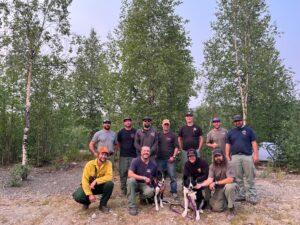 Nils says his dogs are his most versatile tools for preventing bear problems and for teaching people the proper way to coexist with wildlife. They are more effective at detecting and locating wildlife than anything else and they are the most appealing ambassadors imaginable. Just ask the Black Hills, South Dakota, and Whisky Town, California, firefighters. Besides feeling safer with Mardy and Rio around, after a long day of work, the pair can bring a little comfort to the hard-working firefighters on the complex.
Nils says his dogs are his most versatile tools for preventing bear problems and for teaching people the proper way to coexist with wildlife. They are more effective at detecting and locating wildlife than anything else and they are the most appealing ambassadors imaginable. Just ask the Black Hills, South Dakota, and Whisky Town, California, firefighters. Besides feeling safer with Mardy and Rio around, after a long day of work, the pair can bring a little comfort to the hard-working firefighters on the complex.
“I like petting them,” said Laura, a California crew member. “I like hanging out with dogs.”
Author: Karen Robinson, Idaho Team 1. Follow the link below for the original article!
